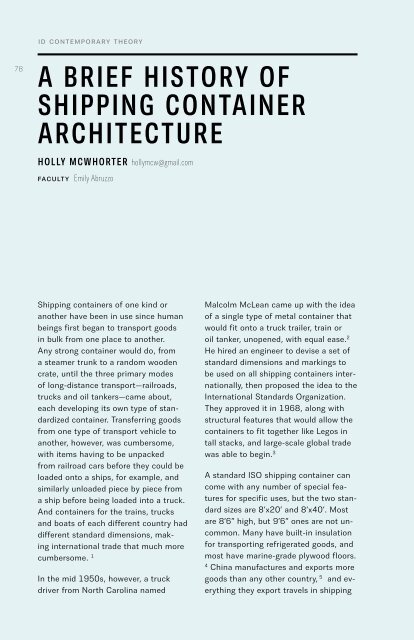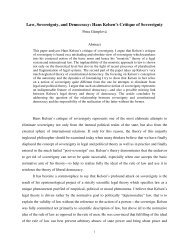PARSONS AAS INTERIOR DESIGN - The New School
PARSONS AAS INTERIOR DESIGN - The New School
PARSONS AAS INTERIOR DESIGN - The New School
You also want an ePaper? Increase the reach of your titles
YUMPU automatically turns print PDFs into web optimized ePapers that Google loves.
78<br />
ID cONTEMPORARy ThEORy<br />
A BRIEF HISTORY OF<br />
SHIPPING CONTAINER<br />
ARCHITECTURE<br />
HOLLY MCWHORTER hollymcw@gmail.com<br />
fAcULTy Emily Abruzzo<br />
Shipping containers of one kind or<br />
another have been in use since human<br />
beings first began to transport goods<br />
in bulk from one place to another.<br />
Any strong container would do, from<br />
a steamer trunk to a random wooden<br />
crate, until the three primary modes<br />
of long-distance transport—railroads,<br />
trucks and oil tankers—came about,<br />
each developing its own type of standardized<br />
container. Transferring goods<br />
from one type of transport vehicle to<br />
another, however, was cumbersome,<br />
with items having to be unpacked<br />
from railroad cars before they could be<br />
loaded onto a ships, for example, and<br />
similarly unloaded piece by piece from<br />
a ship before being loaded into a truck.<br />
And containers for the trains, trucks<br />
and boats of each different country had<br />
different standard dimensions, making<br />
international trade that much more<br />
cumbersome. 1<br />
In the mid 1950s, however, a truck<br />
driver from North Carolina named<br />
Malcolm McLean came up with the idea<br />
of a single type of metal container that<br />
would fit onto a truck trailer, train or<br />
oil tanker, unopened, with equal ease. 2<br />
He hired an engineer to devise a set of<br />
standard dimensions and markings to<br />
be used on all shipping containers internationally,<br />
then proposed the idea to the<br />
International Standards Organization.<br />
<strong>The</strong>y approved it in 1968, along with<br />
structural features that would allow the<br />
containers to fit together like Legos in<br />
tall stacks, and large-scale global trade<br />
was able to begin. 3<br />
A standard ISO shipping container can<br />
come with any number of special features<br />
for specific uses, but the two standard<br />
sizes are 8’x20’ and 8’x40’. Most<br />
are 8’6” high, but 9’6” ones are not uncommon.<br />
Many have built-in insulation<br />
for transporting refrigerated goods, and<br />
most have marine-grade plywood floors.<br />
4 China manufactures and exports more<br />
goods than any other country, 5 and everything<br />
they export travels in shipping

















